#Ōhara
Explore tagged Tumblr posts
Photo

Nestled within the lush embrace of Ohara, Kyoto, Sanzen-in Temple stands as a timeless sanctuary of serenity. Its ancient halls, adorned with exquisite woodwork and delicate garden views, invite visitors into tranquillity and reflection. Meandering pathways lead through moss-covered gardens, where centuries-old stone lanterns stand sentinel amidst whispering pines. Here, amidst the quietude of nature, one can immerse oneself in Japan’s rich spiritual heritage, finding solace and inspiration in every carefully crafted detail.
28 notes
·
View notes
Text

Netsuke of a white rabbit (mid-19th century) by Ōhara Mitsuhiro (Japanese, 1810–1875).
'In Japanese folklore, a rabbit lives in the moon where he pounds rice cakes or prepares the elixir of immortality.'
Image and text information courtesy The Met
393 notes
·
View notes
Text

Rabbit by Ōhara Mitsuhiro. Japanese. Mid 1800s.
The Metropolitan Museum of Art.

Grey Rabbit by William Zorach. Lithuanian-American. 1940s.
The Smithsonian American Art Museum.
#Ōhara Mitsuhiro#William Zorach#art#culture#history#modern history#Japan#American#America#lithuania#Lithuanian#Japanese#japanese history#lithuanian history#American history#museum#sculpture#rabbit#animals in art
13 notes
·
View notes
Text
夏越し大祓 Great Midsummer Purification
I was lucky to be able to participate in the biannual purification ceremony at 3 different shrines when I was in Kyoto.
I first attended the ceremony at Kitano Tenmangū, there were so many people there, and I even got a norito booklet from them that I still have on me. Even though it was raining, so many people showed up. It was also near tanabata so they had their tanabata decorations up. The little white papers you see in the bottom of this photo are a way to purify yourself while the priest uses the Harae-gushi. The bottom right is the priest leading folks through the large woven ring called a Chi no Wa.

Here's the main prayer they chanted during this:
youtube
The second shrine I visited was Hirano Shrine which is right across the street from Kitano Tenmangū, they had a lovely shrine precinct and I got a special Goshuin from them with a chi no wa design.


The videos here are the priests transporting offerings at Kitano Tenmangū, and me walking through the Chi no Wa at Hirano Shrine.
The final shrine I visited was Kamigamo Shrine way up north in the city. This shrine is a pair with Shimogamo shrine in the center of Kyoto. It has lovely scenery and nature.

Here I was able to make a hitokata or the person shaped piece of paper you rub on yourself to purify yourself.

They also had a stunning seasonal goshuin

The main event was at night so I stayed to watch it. During this event priests will read several Waka poems associated with the shrine and then while they chant the Ōharae no Kotoba, they'll release the hitokata into the stream. They also have fires burning all over the shrine grounds so it makes for quite a spectacular scene.

youtube
#Shinto#Great Midsummer Purification#Nagoshi no Ōharae#kitano tenmangu#kitano Tenmangū#hirano shrine#kamigamo shrine#shrines#photos#Videos#goshuin
1 note
·
View note
Text

Hybrid Child: A Novel
By Mariko Ōhara.
0 notes
Text
➠ Mythological and Buddhist symbolism of Yuuji’s domain:
In this post, I (not so) jokingly mentioned Yuuji’s domain being similar to 根の国 (ne-no-kuni, ‘land of roots’; ‘land of origin’), but having thought a bit more about it, there might actually be a chance it is inspired by the concept of Ne-no-kuni, a netherworld in Japanese mythology.
Ne-no-kuni appears with different names and carries various significances in different recordings, but here I mainly want to reference an ancient Shinto prayer, Michiae no matsuri (festival of the road gods, 道饗祭) norito, asking the gods to prevent the evil spirits (such as demons and epidemic gods) from Ne-no-kuni-Soko-no-kuni (根國底國) to do any harm or enter the capital. According to the prayer, sin and impurity were washed away to Ne-no-kuni, which was said to be ruled by Susanoo (a kami Akutami Gege referenced for Sukuna’s domain, more here).
Additionally, according to the Great Purification ceremony (Minatsuki no tsugomori no ōharae (no norito) (六月晦大祓[祝詞])), Hayasasura-hime, a female deity who rules Nenokuni-Sokonokuni removes on that occasion all manner of sins (she takes all the evils, sins, and vice brought into Nenokuni-Sokonokuni and disperses them throughout the underworld), thereby effecting the cleansing of what is called the “sins of the four corners of the land below heaven,” that is, those of the entire country. Therefore, Ne-no-kuni can be considered as both the root of evil spirits and a place where the sins were purified.
Continuing from the idea that Ne-no-kuni was regarded as the world with positive and negative distinctions, some accounts claim that it was originally the land of life. According to the Kojiki (古事記, ‘Records of Ancient Matters’) when Ōkuninushi (one of the central deities of Japanese mythology) visited Ne-no-kuni, he was subjected to the trials (by Susanoo), which are sometimes considered a symbolic death through rites of initiation that cause one to become reborn into a new life. The legend has many variations, but in this version, death does not pollute; it regenerates. And therefore, the land of the dead also contains the forces of life, tama (from the word mitama, the spirit of a kami or the soul of a dead person).
This is where the connection to Yuuji’s domain can be drawn from. From a spiritual perspective, a train station represents the journey of the soul, particularly through different lifetimes or spiritual realms. It could also be seen as a place where one reflects on their life’s path.
In Buddhism, a train station can symbolise concepts such as Transience and Impermanence (train stations are places of constant movement and change, therefore their transient nature reflects the impermanence of all things and is a reminder that nothing is permanent and everything is in a constant state of flux), Journey and Path (train stations can be a metaphor of a journey or path to describe the spiritual quest towards enlightenment, representing the different stages one passes through in life), Karma and Consequence (the choices of routes and destinations at train stations can be seen as a metaphor for karma. Just as each choice leads to a different destination, every action in life leads to specific outcomes), and lastly, Samsara (the cyclical nature of train schedules can be seen as a representation of samsara, the cycle of birth, death, and rebirth. Train stations, as points of both departure and return, can symbolise the repetitive cycles of existence from which one seeks liberation through enlightenment).
Ne-no-kuni represents a threshold between the world of the living and the world of the dead. Similarly, train stations are liminal spaces where people transition from one place to another. They are gateways between different states of being—departing from one environment and arriving at another. From this perspective, Yuuji’s domain being a train station could be such a manifestation of Ne-no-kuni.
To add to this, it has been pointed out that what we are assuming to be Yuuji’s domain resembles Kitakami Station, in the Kitakami City (北上市). To break down the meaning of Kitakami, 北 can mean ‘north, direction, pole’ as well as to flee or to reject, while 上 can mean ‘up, above, top’, i.e. going up, high position, as well as before (in terms of time, order, or flow of things). How can this be tied to Yuuji’s domain and the above case of Ōkuninushi? It can mean going from below to above, as Ne-no-kuni conjures up a netherworld, a place under. Yuuji’s domain is a place where one can travel from below to up or from South to North, which itself can be tied to being reborn into a new life or attaining enlightenment (more on the time, order, or flow of things and rebirth in jjk here) or depending on one’s choice it can also be interpreted as the opposite.
#not sure if this makes sense but...#more on how this ties to yuuji's hand symbol and sukuna and yuuji and possibly megumi later....#jjk spoilers#jujutsu kaisen spoilers#itadori yuuji#sukuna#jjk#yuji itadori#ryomen sukuna#jujutsu kaisen
55 notes
·
View notes
Text
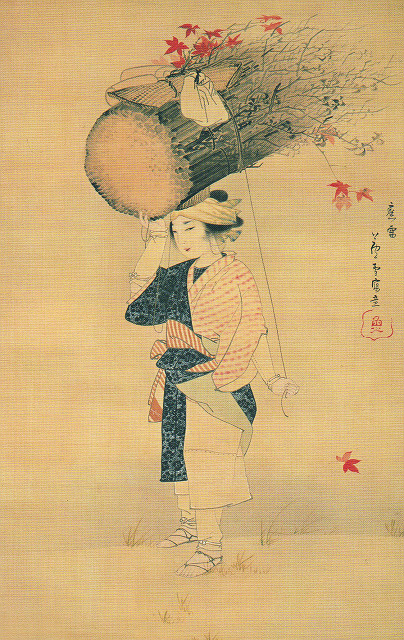
"An Ōhara Girl" (大原女) by Nagasawa Rosetsu (長沢蘆雪) (1754-1799)
38 notes
·
View notes
Text
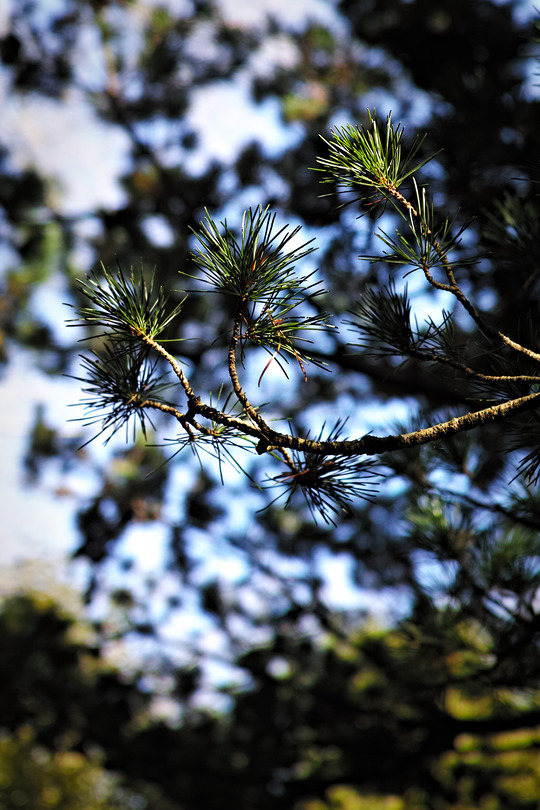
五葉松[Goyōmatsu] Pinus parviflora
五[Go] : Five
葉[Yō] : Leaf
松[Matsu] : Pine tree(Pinus)
It is endemic to Japan and grows in mountainous areas.
The leaves of Matsu are shaped like needles, and while those of 黒松[Kuromatsu](P. thunbergii) and 赤松[Akamatsu](P. densiflora) are two in a bundle, those of this one are five in a bundle, hence the name. And, about the length of their leaves, while Kuromatsu is about fifteen centimeters and Akamatsu is a little over ten centimeters, this one is only about five centimeters.
Because the leaves are shaped like this, Goyōmatsu looks good even when kept small in size, making it very popular not only as a garden tree but also as a bonsai. https://en.wikipedia.org/wiki/Bonsai
Well, there is a seven hundred year old Goyōmatsu in 宝泉院[Hōsen'in] temple in Ōhara, Kyoto, and Haiku poet 高浜 虚子[Takahama Kyoshi](1874 - 1959) is said to have composed the following haiku.
大原や 無住の寺の 五葉の松
[Oohara ya mujū no tera no itsuha(or goyō) no matsu] In Ōhara, there is a magnificent Goyōmatsu at a temple lacking a priest
Apparently there was no resident priest at the time of his visit. Incidentally, this temple is also known for 血天井[Chi-tenjō](Bloody ceiling). https://maps.app.goo.gl/cmPDb6fWssdTdyoUA https://www.youtube.com/watch?v=-zwxiE7KSy0
9 notes
·
View notes
Text
New JTTW Book!!!
La pérégrination vers l'Ouest: Intégrale des estampes de l'édition japonaise de 1806-1837 (English: The Journey to the West: Complete Prints from the Japanese Edition of 1806-1837) This new French publication collects and comments on restored woodblock prints from Ehon Saiyuki (繪本西遊記, 1806-1837), the first complete Japanese translation of Journey to the West. I have scans of the antique Chinese and Japanese versions of JTTW on my blog, and I can say with full confidence that the woodblock prints from the latter are FAR superior. They are gorgeous beyond words. Most are in black and white, but a few are in color.
Here is the official publisher link for those looking to buy:
https://www.editions2024.com/livres/white-boy-2rslx... Below, I present a google-translated version of the product info.
Illustrations by Ōhara Tōya, Utagawa Toyohiro, Katsushika Taito II Text abridged and translated by Evelyne Lesigne-Audoly and Delphine Mulard Introductions and comments by Christophe Marquet, Vincent Durand-Dastès, Xavier Guilbert and Delphine Mulard. Under the direction of Christophe Marquet * 836 two-color & four-color pages on a Holmen Book 2.0 80g * 18 x 24cm * cardboard cover, bowls, attached labels, hot stamping * sewn binding with edge and 2 bookmarks, attached endpapers * ISBN 978-2-383870-79-1 / EAN 9782383870791 * Publication 11/2023
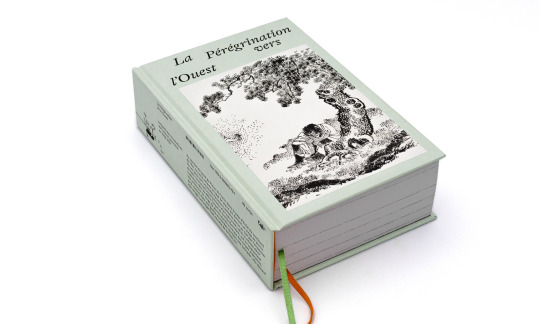
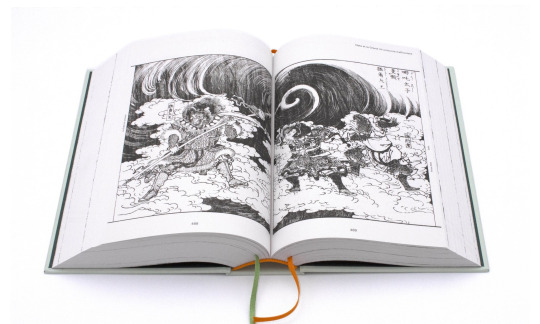

#journey to the west#jttw#sun wukong#monkey king#translation#Japan#japanese prints#japanese woodblock print#french#Lego Monkie Kid#LMK#Japanese art#Asian art#woodblock print
38 notes
·
View notes
Note
Couldn’t the gorosei have just threatened the Ōhara scholars to keep silent about the void century? And to keep it to themselves?
the scholars already knew it was illegal and other archeologists had gotten arrested in the past, and it didn’t work. The Elder Stars wanted to make an example to the world, so they did.
38 notes
·
View notes
Video
youtube
Pretty Guardian Sailor Moon Cosmos the Movie - PV1
Japanese theatrical dates:
Part 1 - June 9, 2023
Part 2 - June 30, 2023
The two-part film serves as a “fifth season” for Sailor Moon Crystal and a direct continuation of Sailor Moon Eternal that will cover the “Stars” arc, the final arc of Naoko Takeuchi’s original manga.

Poster
Cast additions
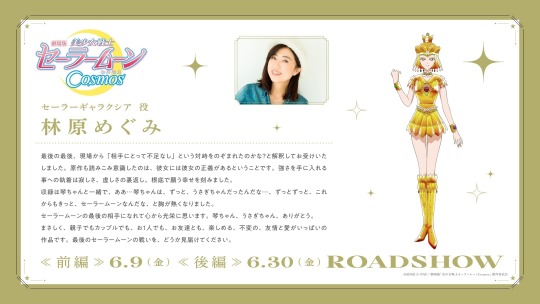
Megumi Hayashibara as Sailor Galaxia

Nana Mizuki as Princess Kakyū
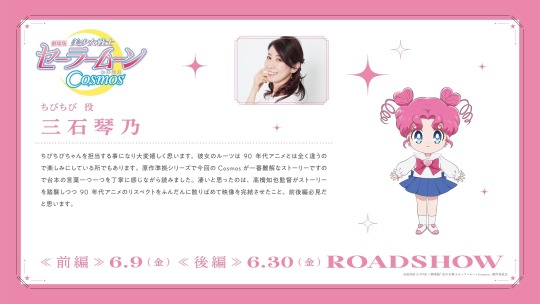
Kotono Mitsuishi as Chibi Chibi
Previously announced cast members
Kotono Mitsuishi as Usagi Tsukino / Sailor Moon
Hisako Kanemoto as Ami Mizuno / Sailor Mercury
Rina Satou as Rei Hino / Sailor Mars
Ami Koshimizu as Makoto Kino / Sailor Jupiter
Shizuka Itō as Minako Aino / Sailor Venus
Misato Fukuen as Chibi-Usa / Sailor Chibi Moon
Ai Maeda as Setsuna Meiou / Sailor Pluto
Sayaka Ōhara as Michiru Kaiou / Sailor Neptune
Junko Minagawa as Haruka Tenou / Sailor Uranus
Yukiyo Fujii as Hotaru Tomoe / Sailor Saturn
Marina Inoue as Seiya Kō/Sailor Star Fighter
Saori Hayami as Taiki Kō/Sailor Star Maker
Ayane Sakura as Yaten Kō/Sailor Star Healer
Staff
Director: Tomoya Takahashi
Script: Kazuyuki Fudeyasu
Character Design: Kazuko Tadano
Music: Yasuharu Takanashi
Art Director: Yumiko Soraga
Animation Production: Toei Animation, Studio Deen
#Pretty Guardian Sailor Moon Cosmos#Bishoujo Senshi Sailor Moon Cosmos#Sailor Moon Cosmos#Pretty Guardian Sailor Moon#Bishoujo Senshi Sailor Moon#Sailor Moon#Sailor Moon Crystal#SMC#Toei Animation#Studio Deen#anime#film#anime film
106 notes
·
View notes
Photo

Nestled within the lush embrace of Ohara, Kyoto, Sanzen-in Temple stands as a timeless sanctuary of serenity. Its ancient halls, adorned with exquisite woodwork and delicate garden views, invite visitors into tranquillity and reflection. Meandering pathways lead through moss-covered gardens, where centuries-old stone lanterns stand sentinel amidst whispering pines. Here, amidst the quietude of nature, one can immerse oneself in Japan’s rich spiritual heritage, finding solace and inspiration in every carefully crafted detail.
21 notes
·
View notes
Photo
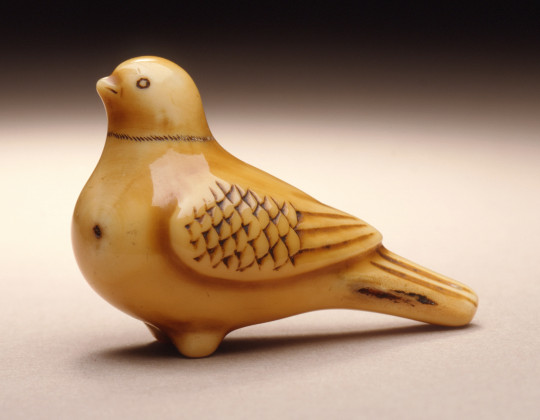
Pigeon-Shaped Flute (Japan, mid-19th century) by Ōhara Mitsuhiro (Japan, 1810-1875).
Ivory with staining.
Image and text information courtesy LACMA.
2K notes
·
View notes
Text
Current Japanese Doraemon voice actors
2005 doblaje actual

Wasabi Mizuta 🐱

Megumi Ōhara 🐢

KAKAZU, YUMI 🐇

SEKI, TOMOKAZU 🦊

KIMURA, SUBARU 🦍

Doraemon 💕💕💕💕




3 notes
·
View notes
Text
Chapter 12: The Ritual of Great Purification
The ritual of Great Purification, while having its mythological roots in the cleansing of Izanagi after his descent into the land of Yomi, was performed at this time of year to answer just that pressing need of the community and its elite overseers. Almost everything bad that one can bring to mind is mentioned in the ritual as tsumi, or “defilements,” of an original state of harmonious existence. Judging from what is considered terrible in the eyes of the Kami (and by extension, the sociolppoitical order they legitimated), one can p sit that a state of harmony exist when rice grows in well-managed and maintained irrigated fields, when human beings cooperate in this endeavor and share the joys and sorrows of their lives within the embrace of the four seasons, the watchful mountains, and the bountiful seas, and when praise and gratitude to the Kami are a part of everyday household and communal administration.
—Pages 105-106
The video below is the full recording of the Ritual of Great Purification from Kitano Tenmangū, that I took last year!
youtube
As a result of the exorcism and the purification,
There will be no sins left.
They will be taken into the great ocean
By the goddess called Se-ori-tu-hike,
Who dwells in the rapids of the rapid-running rivers
which fall surging perpendicular
from the summits of high and low mountains.
When she thus takes them,
They will be swallowed with a gulp
By the goddess Haya-aki-tu-hime,
Who dwells in the wild brine, the myriad currents of the brine,
When she thus swallows them with a gulp,
The deity called Haya-sasura-hime,
Who dwells in the land of Hades, the under-world,
Will wander off with them and lose them.
When she thus loses them,
Beginning with the many officials serving in the
Emperor’s court,
In the four quarters under the heavens,
Beginning from today,
Each and Every sin will be gone.
—Excerpt from the Ōharae no Kotoba, the prayer said during the Ritual of Great Purification
(Philippi 1959, 45-49) Pages 110-111


Pictures showing Katashiro, and a Chi no Wa, common scenes during the annual Ritual of Great Purification. (Do not use without my permission)
…Oka-san shouts out the words to the song they will sing as they weave in a figure-eight pattern through the ring of purification…
Mina-zuki no nagoshi no harae suru hito wa sen yowai nobuto iu nari…
All people who do the harae of the sixth month are said to lengthen their lives a thousandfold…
It is a beautiful sight at the priests, businessmen, grandmothers, Mike, schoolchildren, toddlers, babies strapped on their mothers/ backs, even a couple foreigners, all slowly proceed through the ring, each time “cleaner” than before, each time the song a little truer in their voices. No one acts embarrassed or as if they are a century too late to benefit from the magic of the rite—a quick glance at the faces reveals enjoyment and absorption in the moment.
—Page 111
1 note
·
View note
Text
Times the fourth wall has been broken or referenced in Doraemon:
The Doraemon theme song exists in the world of Doraemon.
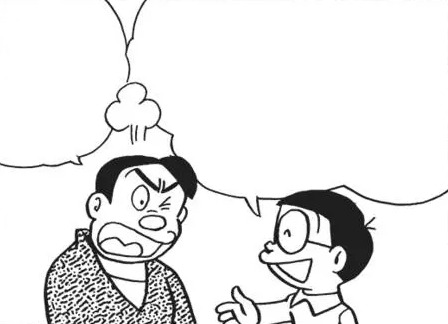
Nobita asks his father not to lecture too long or else readers will lose interest in the manga, but his father insists on speaking for about 2 pages.
Source: くろうみそ, 1975 (manga)
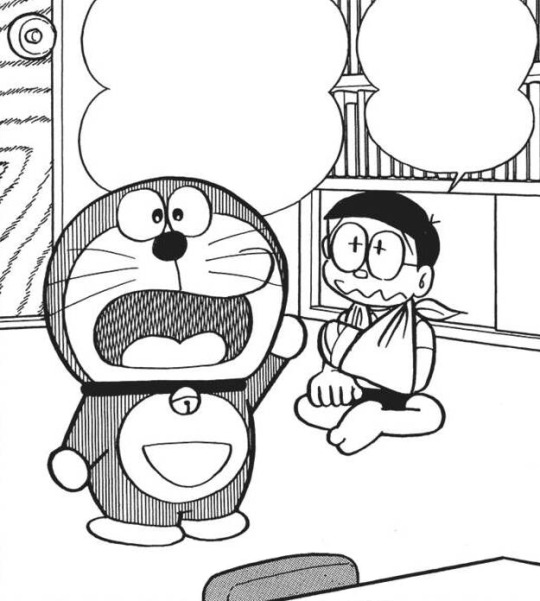
Nobita injures himself after the effect of the “Karate Drink” (空手ドリンク) wears off, so Doraemon warns readers not to try the same thing at home.
Source: 空手ドリンク, 1976 (manga)

Nobita gets lost on a deserted island for 10 years, and panics because him growing up means the manga will end.
Source: 無人島へ家出, 1977 (manga)

Doraemon says they need to act fast to stop Gian from singing, because the story only has 6 pages.
Source: 念録マイク, 1977 (manga)
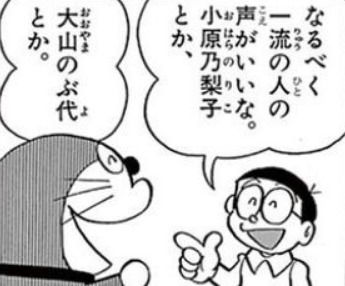
When Nobita and Doraemon discuss good voice acting, they name their own voice actors from the 1979 anime as examples. (Noriko Ohara for Nobita and Nobuyo Ōyama for Doraemon.)
In the 2005 anime’s adaptation of this story, they name their voice actors from that series. (Megumi Ōhara for Nobita and Wasabi Mizuta for Doraemon.)
Source: アニメ制作なんてわけないよ, 1980 (manga)
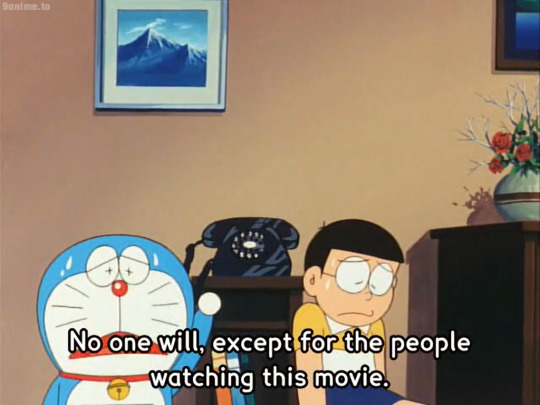
After failing to convince the authorities that the steel troops are about to invade Earth, Doraemon says the viewers are the only people who would believe them.
Source: Nobita and the Steel Troops, 1986
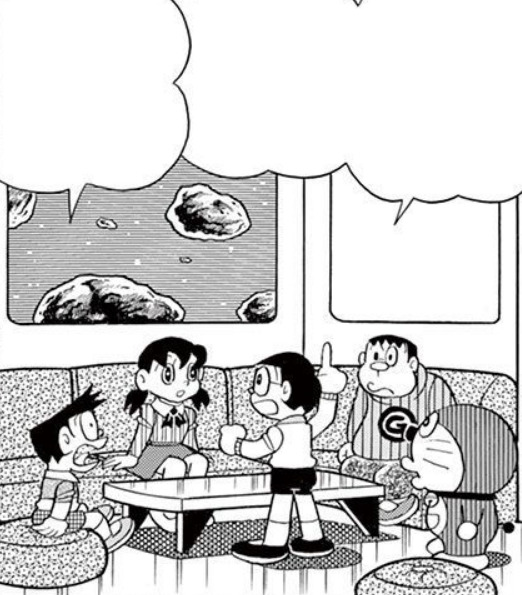
Suneo comments that Nobita becomes more spirited in the Long Stories.
Source: Nobita and the Galaxy Super-express, 1996 (manga, Doraemon Long Stories)
76 notes
·
View notes